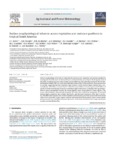Use este identificador para citar ou linkar para este item:
http://www.alice.cnptia.embrapa.br/alice/handle/doc/972831Registro completo de metadados
| Campo DC | Valor | Idioma |
|---|---|---|
| dc.contributor.author | BAKER, I. T. | pt_BR |
| dc.contributor.author | HARPER, A. B. | pt_BR |
| dc.contributor.author | ROCHA, H. R. da | pt_BR |
| dc.contributor.author | DENNING, A. S. | pt_BR |
| dc.contributor.author | ARAUJO, A. C. | pt_BR |
| dc.contributor.author | BORMA, L. S. | pt_BR |
| dc.contributor.author | FREITAS, H. C. | pt_BR |
| dc.contributor.author | GOULDE, M. L. | pt_BR |
| dc.contributor.author | MANZI, A. O. | pt_BR |
| dc.contributor.author | MILLER, S. D. | pt_BR |
| dc.contributor.author | NOBRE, A. D. | pt_BR |
| dc.contributor.author | RESTREPO-COUPE, N. | pt_BR |
| dc.contributor.author | SALESKA, S. R. | pt_BR |
| dc.contributor.author | STÖCKLI, R. | pt_BR |
| dc.contributor.author | RANDOW, C. von | pt_BR |
| dc.contributor.author | WOFSY, S. C. | pt_BR |
| dc.date.accessioned | 2013-12-03T11:11:11Z | pt_BR |
| dc.date.available | 2013-12-03T11:11:11Z | pt_BR |
| dc.date.created | 2013-12-03 | pt_BR |
| dc.date.issued | 2013 | pt_BR |
| dc.identifier.citation | Agricultural and Forest Meteorology, v. 182-183, p. 177-188, Dec. 2013. | pt_BR |
| dc.identifier.uri | http://www.alice.cnptia.embrapa.br/alice/handle/doc/972831 | pt_BR |
| dc.description | Surface ecophysiology at five sites in tropical South America across vegetation and moisture gradients is investigated. From the moist northwest (Manaus) to the relatively dry southeast (Pé de Gigante, state of São Paulo) simulated seasonal cycles of latent and sensible heat, and carbon flux produced with the Simple Biosphere Model (SiB3) are confronted with observational data. In the northwest, abundant moisture is available, suggesting that the ecosystem is light-limited. In these wettest regions, Bowen ratio is consistently low, with little or no annual cycle. Carbon flux shows little or no annual cycle as well; efflux and uptake are determined by high-frequency variability in light and moisture availability. Moving downgradient in annual precipitation amount, dry season length is more clearly defined. In these regions, a dry season sink of carbon is observed and simulated. This sink is the result of the combination of increased photosynthetic production due to higher light levels, and decreased respiratory efflux due to soil drying. The differential response time of photosynthetic and respiratory processes produce observed annual cycles of net carbon flux. In drier regions, moisture and carbon fluxes are in-phase; there is carbon uptake during seasonal rains and efflux during the dry season. At the driest site, there is also a large annual cycle in latent and sensible heat flux. | pt_BR |
| dc.language.iso | eng | eng |
| dc.rights | openAccess | eng |
| dc.subject | Ciclo do carbono | pt_BR |
| dc.subject | Ecofisiologia | pt_BR |
| dc.subject | América do Sul | pt_BR |
| dc.title | Surface ecophysiological behavior across vegetation and moisture gradients in tropical South America. | pt_BR |
| dc.type | Artigo de periódico | pt_BR |
| dc.date.updated | 2017-10-16T11:11:11Z | pt_BR |
| dc.subject.nalthesaurus | Amazonia | pt_BR |
| riaa.ainfo.id | 972831 | pt_BR |
| riaa.ainfo.lastupdate | 2017-10-16 -02:00:00 | pt_BR |
| dc.identifier.doi | http://dx.doi.org/10.1016/j.agrformet.2012.11.015 | pt_BR |
| dc.contributor.institution | COLORADO STATE UNIVERSITY; COLORADO STATE UNIVERSITY; HUMBERTO R. DA ROCHA, USP; COLORADO STATE UNIVERSITY; ALESSANDRO CARIOCA DE ARAUJO, CPATU; INPE; USP; UNIVERSITY OF CALIFORNIA; INPA; State University of New York at Albany; INPA / INPE; NATALIA RESTREPO-COUPE, UNIVERSITY OF ARIZONA / UNIVERSITY OF TECHNOLOGY; UNIVERSITY OF ARIZONA; Climate Services, Climate Analysis, MeteoSwiss; CELSO VON RANDOW, INPE; HARVARD UNIVERSITY. | pt_BR |
| Aparece nas coleções: | Artigo em periódico indexado (CPATU)  | |
Arquivos associados a este item:
| Arquivo | Descrição | Tamanho | Formato | |
|---|---|---|---|---|
| Carioca1.pdf | 2.09 MB | Adobe PDF |  Visualizar/Abrir |









